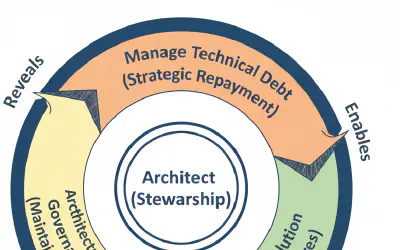The Architect's Compass
A Tale of Speed vs. Scale
Part of the From Patterns to Practice series
Imagine this: you’re the new software architect at a promising startup, ‘CityPulse.’ On your first day, you get pulled into two critical conversations that will define your job for the foreseeable future. First, the CEO catches you in the hallway. “Welcome aboard! Our main competitor launches their platform in four months. We have to beat them. I need our platform live in three, no exceptions.” An hour later, your lead engineer finds you at your desk. “I’m glad you’re here,” she says. “That timeline is aggressive. My fear is that the moment a popular concert goes on sale, our whole site is going to crash and burn. We need to build this thing to scale.”
And there it is. Your first major test as an architect. The business is demanding speed. Your engineering team is demanding stability. Both are right. So, where do you even begin? This conflict isn’t just a hypothetical scenario. Learning how to navigate it is the job. It’s the true essence of software architecture.
From Business Problems to Concrete Drivers
So, what do you do with this conflict? You don’t jump to a solution. Your first job as an architect is to translate these competing business pressures into a professional vocabulary. You give them names. The CEO’s deadline becomes Time-to-Market. Your engineer’s fear of a crash becomes Scalability and Reliability. These “ilities” are what we formally call Quality Attributes.
Your Real Job: The Art of the Trade-Off
So what is your real job here? It’s not just to be the technical expert. It’s to stand in the middle of this tension and facilitate a conscious, deliberate choice. You do this by making the trade-offs explicit.
Architect's Log
I’ve seen too many projects fail because they never had the hard conversation. The business wanted one thing, the engineers wanted another, and instead of forcing a decision, they tried to do both and ended up with a mess. Your first job as an architect is to force that conversation to happen, and naming the Quality Attributes is how you start. It gives you a professional vocabulary to turn a vague cloud of anxiety into a concrete list of trade-offs that can be properly debated.You have to translate the technical risks into business impact. What is the actual cost to the business if the site goes down during the sale? Is it a few thousand dollars in lost revenue, or is it a catastrophic loss of user trust that kills the company before it even starts? You need to find out. What is the real risk of missing the CEO’s deadline? Will a competitor gain a permanent, insurmountable foothold? Or is the date just an arbitrary goal?
Your job is to expose these questions and guide the organization to an answer, ensuring they actively choose their priorities, rather than stumbling into a disaster by accident.
Sketching the Extremes: A Thought Experiment
Now that you have concrete drivers, how do you start thinking about a solution? A good way to start is to explore the two most extreme options. This helps you understand the landscape of trade-offs you’re working with.
On the other hand, you could break the system into small, independent services—a microservices architecture. This directly serves your scalability driver. You could have a ‘Ticketing Service’ that scales independently to handle the immense load. The trade-off here is a massive hit to your Time-to-Market driver. The complexity of a distributed system—networking, data consistency, deployment—is huge, and almost certainly makes a three-month launch impossible.
These two extremes aren’t your only choices, but exploring them has clearly defined the battlefield: you’re fighting a war between speed and scale.
Architect's Log
Be careful of the ‘false dichotomy.’ The world isn’t just monoliths and microservices. These are poles on a spectrum. In the real world, many of the best solutions are hybrids: a ‘well-structured monolith’ with clear internal modules, or a ‘mini-services’ approach with a few, coarse-grained services instead of dozens of tiny ones. Exploring the extremes is a tool for analysis, not a menu to order from.Key Takeaways:
- The architect’s primary job is to translate vague business conflicts (like speed vs. scale) into concrete, technical trade-offs.
- Before you can solve a problem, you must understand the real-world pressures and name them (e.g., Time-to-Market, Scalability).
- Exploring the extreme architectural options first is a good way to understand the landscape of the problem you need to solve.
It’s About Choosing Your Problems
The choice isn’t about which technology is “best.” It’s about which set of trade-offs you’re willing to accept to serve the unique, conflicting needs of your business. You’re caught between the vague demands of “speed” and “scale.” So what’s the first thing a professional architect does? You don’t guess. You analyze.
Ultimately, remember the most important lesson:
Architectural decisions must be based on the specific, unique context of your business problem, not on generic ‘best practices’ or popular trends.
In our next post, we’ll walk through the process of turning this conflict into a set of concrete, measurable drivers.
Further Reading
- Software Architecture: The Hard Parts by Neal Ford, Mark Richards, et al. The definitive book on the nature of architectural trade-offs.
- “Quality Attributes” from the Software Engineering Institute (SEI) at Carnegie Mellon, the origin of much of this foundational thinking.
- Martin Fowler’s article on the Utility vs. Strategic Dichotomy, which adds excellent nuance to the “build it fast vs. build it right” conflict.
In the comments below, tell me about a time you faced a conflict between “building it fast” and “building it right.” How did you navigate it?



